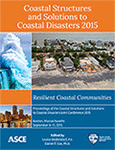Coastal Structures and Solutions to Coastal Disasters Joint Conference 2015
Wave Transmission through Artificial Reef Breakwaters
Publication: Coastal Structures and Solutions to Coastal Disasters 2015: Resilient Coastal Communities
ABSTRACT
The use of artificial reefs as wave attenuating structures is becoming more common in the design of living shoreline projects. Unfortunately, their behavior and performance are not widely known. A series of geometrically scaled laboratory experiments were conducted to measure wave transmission behind bagged oyster shell breakwaters, concrete wave transmission frustums, and triangular oyster shell cages. The experiments covered a range of water depths and wave characteristics representative of conditions commonly encountered at project sites throughout the Gulf Coast. The wave attenuating capabilities of the various structures are described in terms of hydrodynamic parameters and structure geometries. Experimental results reveal strong correlations between wave transmission and simple, dimensionless parameters. However, existing methods for estimating wave transmission through rubble mound structures do not provide accurate estimates for these structures. This work will lead to the development of simple predictive equations for estimating wave transmission coefficients, within an appropriate range of uncertainty, for these complex and unique non-rock alternatives.
Get full access to this article
View all available purchase options and get full access to this chapter.
ACKNOWLEDGMENTS
This research was made possible through support provided by the U.S. Department of Commerce through the National Oceanic and Atmospheric Administration through The University of Southern Mississippi under terms of Agreement No. NA10OAR4170078. The opinions expressed herein are those of the authors and do not necessarily reflect the views of the U.S. Department of Commerce, the National Oceanic and Atmospheric Administration or The University of Southern Mississippi.
REFERENCES
Ahrens, J. (1984). “Reef type breakwaters.” Proc., 19th International Conference on Coastal Engineering, ASCE, Reston, VA, 2648-2662.
Allen, R. J. and Webb, B. M. (2011). “Determination of wave transmission coefficients for oyster shell bag breakwaters.” Proc., Conference on Coastal Engineering Pratice, ASCE, Reston, VA, 684-697.
Armono, H. D. and Hall, K. (2003). “Wave transmission on submerged breakwaters made of hollow hemispherical shape artificial reefs.” Proc., 31st Annual Conference of the Canadian Society for Civil Engineering, Canadian Society for Civil Engineering, New Brunswick, Canada.
Carter, J., Fenical, S., Harter, C., and Todd, J. (2015). “CFD modeling for analysis of living shoreline structure performance.” Proc., Conference on Coastal Structures and Solutions to Coastal Disasters, ASCE, Reston, VA.
d'Angremond, K. V., Van der Meer, J. W., and De Jong, R. J. (1996). “Wave transmission at low crested stuctures.” Proc., 25th International Conference on Coastal Engineering, ASCE, Reston, VA, 3305-3318.
DeQuattro, J. (2010). “Coastal restoration at work: coastal Alabama restoration.” 5th National Conference on Coastal and Estuarine Habitat Restoration. Restore America’s Estuaries. Galveston, Texas. (Presentation)
Douglass, S. L., Ferraro, C., Dixon, C. R., Oliver, L., and Pitts, L. (2012). “A Gulf of Mexico marsh restoration and protection project.” Proc., 33rd International Conference on Coastal Engineering, ASCE, Reston, VA.
Goda, Y., Takeda, H., and Moriya, Y. (1967). “Laboratory Investigation on Wave Transmission over Breakwaters.” Port and Harbour Technical Research Institute, Report No. 13, Ministry of Transport, Yokosuka, Japan.
Hall, W. C. and Hall, J. V. (1940). “A Model Study of the Effect of Submerged Breakwaters on Wave Action.” Beach Erosion Board, U.S. Army Corps of Engineers, Washington, D.C.
Jeffreys, H. (1944). “Note on the Offshore Bar Problem and Reflection from a Bar.” Great Britain. Ministry of Supply, Wave Report 3.
Murakami, K. and Maki, D. (2011). “Wave breaking and wave setup of artificial reef with inclined crown.” Proc., 32nd International Conference on Coastal Engineering, ASCE, Reston, VA.
Reed, H. (2012). “A comparison of breakwater effectiveness in various types of designs in relation to the high wave impact area of Deadman’s Island, Gulf Breeze Florida.” Mississippi-Alabama Bays and Bayous Symposium, Mississippi-Alabama Sea Grant Consortium, Biloxi, MS. (Presentation)
Seebrook, S. R. and Hall, K. R. (1998). “Wave transmission at submerged rubblemound breakwaters.” Proc., 26th International Conference on Coastal Engineering, ASCE, Reston, VA, 2000-2013.
Seelig, W. (1980). Two-Dimensional Tests of Wave Transmission and Reflection Characteristics of Laboratory Breakwaters. U.S. Army Corps of Engineers Waterways Experiment Station, Vicksburg, MS.
Servold, K., Webb, B. M., and Douglass, S. L. (2015). “Effects of low-crested living shoreline breakwaters on wave setup.” Proc., Conference on Coastal Structures and Solutions to Coastal Disasters, ASCE, Reston, VA.
Takayama, T., Nagai, K., and Sekiguchi, T. (1985). “Irregular wave experiments on wave dissipation function of submerged breakwater with wide crown.” Proc., 32nd Conference on Coastal Engineering, Japanese Society of Civil Engineers, 545-549. (Japanese Text)
U.S. Army Corps of Engineers. (2002). Coastal Engineering Manual. Engineering Manual 1110-2-1100, U.S. Army Corps of Engineers, Washington D.C.
Van der Meer, J. W., Briganti, R., Zanuttigh, B., and Wang, B. (2005). “Wave transmission and reflection at low-crested structures: design formulae, oblique wave attack, and spectral change.” Journal of Coastal Engineering, 52, 915-929.
Van der Meer, J. and d'Angremond, K. (1991). “Wave transmission at low crested stuctures.” Coastal Stuctures and Breakwaters. Institution of Civil Engineers, London, England, 25-42.
Information & Authors
Information
Published In
Coastal Structures and Solutions to Coastal Disasters 2015: Resilient Coastal Communities
Pages: 432 - 441
Editors: Louise Wallendorf, U.S. Naval Academy and Daniel T. Cox, Ph.D., Oregon State University
ISBN (Online): 978-0-7844-8030-4
Copyright
© 2017 American Society of Civil Engineers.
History
Published online: Jul 11, 2017
Authors
Metrics & Citations
Metrics
Citations
Download citation
If you have the appropriate software installed, you can download article citation data to the citation manager of your choice. Simply select your manager software from the list below and click Download.
